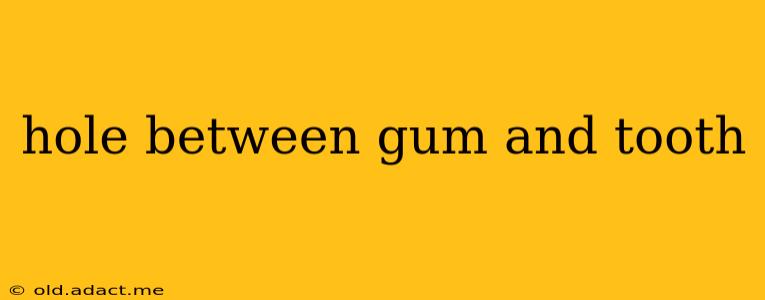A hole between your gum and tooth, often accompanied by sensitivity or pain, is a serious issue that requires professional attention. This space, technically known as gum recession, exposes the root of your tooth, making it vulnerable to decay, infection, and even tooth loss. Understanding the causes, symptoms, and treatment options is crucial for preserving your oral health.
What Causes a Hole Between Gum and Tooth?
Several factors contribute to the development of a hole between your gum and tooth. Let's explore some of the most common causes:
- Aggressive brushing: Brushing too hard or using a hard-bristled toothbrush can damage your gums over time, leading to recession.
- Gum disease (periodontal disease): This is a major culprit. Bacteria build up, causing inflammation and infection that destroys the gum tissue and bone supporting your teeth.
- Genetics: Some individuals are genetically predisposed to gum recession, regardless of their oral hygiene practices.
- Grinding or clenching teeth (bruxism): This puts excessive pressure on the teeth and gums, contributing to recession.
- Smoking: Smoking impairs the body's ability to heal and fight infection, worsening gum disease and recession.
- Misaligned teeth (malocclusion): Poorly aligned teeth can put extra stress on certain areas of the gums, increasing the risk of recession.
- Hormonal changes: Fluctuations in hormone levels, particularly during pregnancy or menopause, can make gums more susceptible to recession.
- Certain medical conditions: Some medical conditions and medications can also contribute to gum recession.
How Do I Know If I Have a Hole Between My Gum and Tooth?
Recognizing the symptoms early is critical. Here are some common signs of gum recession:
- Visible tooth roots: You may notice more of your tooth showing than usual.
- Sensitivity to hot and cold: Exposed roots are more sensitive to temperature changes.
- Bleeding gums: Bleeding during brushing or flossing is a sign of gum irritation and potential infection.
- Loose teeth: In advanced cases, gum recession can lead to loose teeth.
- Persistent bad breath: Gum disease often produces bad breath.
- Red, swollen, or tender gums: Inflammation is a key indicator of gum problems.
What are the Treatments for a Hole Between Gum and Tooth?
Treatment options depend on the severity of the gum recession and the underlying cause. Your dentist will develop a personalized treatment plan, which may include:
- Scaling and root planing: A deep cleaning procedure to remove plaque and tartar from below the gum line.
- Antibiotics: To combat bacterial infection if gum disease is present.
- Gum grafting: A surgical procedure where gum tissue is taken from another area of the mouth (or a donor) and grafted onto the affected area to cover the exposed tooth roots.
- Guided tissue regeneration (GTR): A surgical technique that encourages the regrowth of gum tissue and bone.
- Dental crown lengthening: A procedure to improve the appearance of teeth that have been exposed due to gum recession.
- Improved oral hygiene techniques: Your dentist will teach you proper brushing and flossing techniques to prevent further recession.
Can I Prevent a Hole Between My Gum and Tooth?
Yes, you can significantly reduce your risk of gum recession by adopting good oral hygiene practices and regular dental checkups. Here's what you can do:
- Brush gently twice a day: Use a soft-bristled toothbrush and gentle circular motions.
- Floss daily: Flossing removes plaque and food particles from between your teeth.
- Use mouthwash: An antibacterial mouthwash can help control bacteria.
- See your dentist regularly: Regular checkups and cleanings are essential for early detection and treatment of gum disease.
- Quit smoking: Smoking significantly increases the risk of gum disease.
- Manage stress: Stress can exacerbate gum disease.
- Address bruxism: If you grind or clench your teeth, your dentist can provide solutions like mouthguards.
How Can I Improve My Gum Health?
Improving your gum health is crucial for preventing and treating gum recession. In addition to the preventative measures listed above, consider these tips:
- Eat a healthy diet: A balanced diet rich in fruits, vegetables, and whole grains supports overall health, including gum health.
- Stay hydrated: Drinking plenty of water helps wash away food particles and bacteria.
- Limit sugary drinks and snacks: Sugary foods feed bacteria, contributing to gum disease.
Is a Hole Between My Gum and Tooth a Serious Problem?
Yes, a hole between your gum and tooth (gum recession) is a serious problem if left untreated. It can lead to tooth sensitivity, infection, tooth loss, and other oral health complications. Early detection and prompt treatment are crucial for preserving your teeth and gums.
This information is for educational purposes only and does not constitute medical advice. Always consult with a qualified dental professional for diagnosis and treatment of any oral health concerns.
